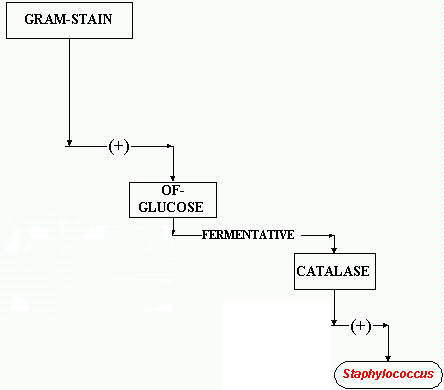STAPHYLOCOCCUS
STAPHYLOCOCCUS
(under the microscope)
 Clinically, the most important genus of the Micrococcaceae family is Staphylococcus.
The Staphylococcus genus is classified into two major groups: aureus and non-aureus.
S. aureus is a the cause of soft tissue infections, as well as toxic shock syndrome
(TSS). It can be distinguished from other species of Staphylococcus by
a positive result in a coagulase test (all other species are negative).
Clinically, the most important genus of the Micrococcaceae family is Staphylococcus.
The Staphylococcus genus is classified into two major groups: aureus and non-aureus.
S. aureus is a the cause of soft tissue infections, as well as toxic shock syndrome
(TSS). It can be distinguished from other species of Staphylococcus by
a positive result in a coagulase test (all other species are negative).
The pathogenic effects of Staphylococcus are mainly asssociated with the toxins it produces.
Most of these toxins are produced in the stationary phase of the bacterial growth curve.
In fact, it is not uncommon for an infected site to contain no viable Staphylococcus cells. The
S. aureus enterotoxin causes quick onset food poisoning which can lead to cramps and severe
vomiting. Infection can be traced to contaminated meats which have not been fully cooked.
These microbes also secrete leukocidin, a toxin which destroys white blood cells and leads to the
formation of puss and acne. Particularly, S. aureus has been found to be the causative
agent in such ailments as pneumonia, meningitis, boils, arthritis, and osteomyelitis
(chronic bone infection). Most S. aureus are penicillin resistant, but vancomycin and
nafcillin are known to be effective against most strains.
Of the non-aureus species, S. epidermidis is the most clinically significant.
This bacterium is an opportunistic pathogen which is a normal resident of human skin. Those
susceptible to infection by the bacterium are IV drug users, newborns, elderly, and those
using catheters or other artificial appliances. Infection is easily treatable with vancomycin or rifampin.
LABORATORY INDICATIONS:
- Anaerobic glucose fermentation with acid production
- Catalase +
- Nitrate +
- Coagulase +





Copyright © 1995 University of Texas - Houston Medical School, DPALM MEDIC, All rights reserved.
 Clinically, the most important genus of the Micrococcaceae family is Staphylococcus.
The Staphylococcus genus is classified into two major groups: aureus and non-aureus.
S. aureus is a the cause of soft tissue infections, as well as toxic shock syndrome
(TSS). It can be distinguished from other species of Staphylococcus by
a positive result in a coagulase test (all other species are negative).
Clinically, the most important genus of the Micrococcaceae family is Staphylococcus.
The Staphylococcus genus is classified into two major groups: aureus and non-aureus.
S. aureus is a the cause of soft tissue infections, as well as toxic shock syndrome
(TSS). It can be distinguished from other species of Staphylococcus by
a positive result in a coagulase test (all other species are negative).




